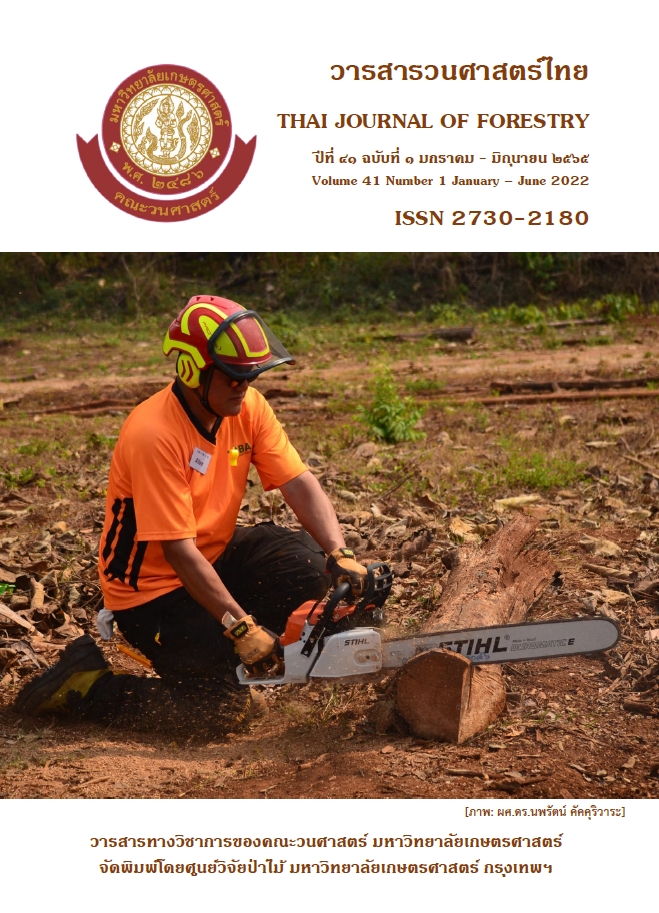การพัฒนาและทดสอบแบบจำลองสำหรับฝึกทักษะการใช้เลื่อยโซ่ยนต์ลิดกิ่ง
Main Article Content
บทคัดย่อ
การทำไม้มีการใช้เลื่อยโซ่ยนต์เป็นจำนวนมาก ซึ่งต้องอาศัยทักษะการทำงานค่อนข้างสูงเนื่องจากเป็นการทำงานที่ยาก สกปรก และมีความอันตราย การใช้โมเดลจำลองเพื่อฝึกทักษะการใช้เลื่อยโซ่ยนต์ก่อนปฏิบัติงานจริงจึงเป็นสิ่งจำเป็น ด้วยเหตุนี้ผู้วิจัยจึงได้พัฒนาแบบจำลองสำหรับฝึกทักษะและศึกษาความสัมพันธ์ระหว่างทักษะที่เพิ่มขึ้นกับเวลาที่ใช้ และปัจจัยอื่นที่อาจจะมีผลต่อการพัฒนาทักษะด้วยแบบจำลอง จากการศึกษาพบว่าระยะเวลาในการลิดกิ่งไม่แตกต่างกันระหว่างกลุ่มประชากรที่มีทักษะและไม่มีทักษะการใช้เลื่อยโซ่ยนต์ จากการวิเคราะห์ด้วยโปรแกรมทางสถิติไม่พบความแตกต่างของค่าเฉลี่ยระหว่างกลุ่มประชากรถึงแม้ว่ากราฟแสดงทักษะการเรียนรู้ของกลุ่มประชากรผู้ที่ไม่มีทักษะมีการกระจายของข้อมูลที่มากกว่า และมีแนวโน้มการใช้เวลาคงที่ในรอบที่ 7 และ 8 ในขณะที่ผู้มีทักษะเวลาจะคงที่ในรอบที่ 5 และ 6 การทดลองซ้ำ ๆ ก่อให้เกิดทักษะการลิดกิ่งที่ดีขึ้นและมีแนวโน้มของการใช้เวลาที่ลดลง การจำแนกกลุ่มตัวอย่างตามเพศพบว่าเพศชายและหญิงมีความแตกต่างกันอย่างไม่มีนัยสำคัญทางสถิติ ส่วนการจำแนกตามค่าดัชนีมวลกาย (BMI) พบว่ามีผลต่อระยะเวลาในการลิดกิ่งอย่างมีนัยสำคัญทางสถิติ อาจเนื่องจากน้ำหนักของเลื่อยโซ่ยนต์ที่ส่งผลให้ผู้ทดสอบเกิดภาวะอ่อนล้าต่างกัน ทำให้ส่งผลต่อเวลาที่เพิ่มขึ้นโดยเฉพาะผู้ที่อยู่ในเกณฑ์ผอม แบบจำลองดังกล่าวสามารถช่วยให้ผู้ทดลองเกิดความชำนาญและความคุ้นเคยกับเลื่อยโซ่ยนต์ซึ่งส่งผลให้การไปปฏิบัติงานจริงในสนามทำได้ง่ายขึ้น
Downloads
Article Details

อนุญาตภายใต้เงื่อนไข Creative Commons Attribution-NonCommercial-NoDerivatives 4.0 International License.
ข้าพเจ้าและผู้เขียนร่วม (ถ้ามี) ขอรับรองว่า ต้นฉบับที่เสนอมานี้ยังไม่เคยได้รับการตีพิมพ์และไม่ได้อยู่ในระหว่างกระบวนการพิจารณาตีพิมพ์ลงในวารสารหรือสิ่งตีพิมพ์อื่นใด ข้าพเจ้าและผู้เขียนร่วม (ถ้ามี) ยอมรับหลักเกณฑ์และเงื่อนไขการพิจารณาต้นฉบับ ทั้งยินยอมให้กองบรรณาธิการมีสิทธิ์พิจารณาและตรวจแก้ต้นฉบับได้ตามที่เห็นสมควร พร้อมนี้ขอมอบลิขสิทธิ์ผลงานที่ได้รับการตีพิมพ์ให้แก่วารสารวนศาสตร์ คณะวนศาสตร์ มหาวิทยาลัยเกษตรศาสตร์ กรณีมีการฟ้องร้องเรื่องการละเมิดลิขสิทธิ์เกี่ยวกับภาพ กราฟ ข้อความส่วนใดส่วนหนึ่ง หรือ ข้อคิดเห็นที่ปรากฏในผลงาน ให้เป็นความรับผิดชอบของข้าพเจ้าและผู้เขียนร่วม (ถ้ามี) แต่เพียงฝ่ายเดียว และหากข้าพเจ้าและผู้เขียนร่วม (ถ้ามี) ประสงค์ถอนบทความในระหว่างกระบวนการพิจารณาของทางวารสาร ข้าพเจ้าและผู้เขียนร่วม (ถ้ามี) ยินดีรับผิดชอบค่าใช้จ่ายทั้งหมดที่เกิดขึ้นในกระบวนการพิจารณาบทความนั้น”
เอกสารอ้างอิง
Boonsaen, T. 2019. Why is Body Mass Index Important. Faculty of Medicine Siriraj Hospital Mahidol University, Bangkok. (in Thai)
Brangenfeldt, E., Lindroos, O. 2015. Evaluation of the educational influence on forwarding planning capacity. FORMEC 2015. Linz, Austria.
Chai-inkha, P. 2013. Factors Affecting the Use of Personal Protective Equipment. M.E. Thesis, Suranaree University of Technology. (in Thai)
Inhelder and Piaget. 1958. Learning Principles. Available source: https://sites.google. com/site/jinymayong/hlak-kar/hlak-ar-reiyn-ru, March 2, 2020. (in Thai)
Laksana, S. 2001. Development of Work Efficiency. Faculty of Management Science Suan Sunandha Rajabhat University, Bangkok. (in Thai)
Nitami, T., Sooil, S. 2017. Smart chainsaw ICT and IoT on manual chainsaw operation for safety and productivity at forestry operation, pp. 302-305. In S.V.C. Fundación, ed. International Symposium of Forest Mechanization 2018. September 24-28, 2018. Madrid, Spain.
Robba, W., Cockingb, J. 2014. Review of European chainsaw fatalities, accidents, and trends. Arboricultural Journal: The International Journal of Urban Forestry 36(2): 103-126.
Social Security Office. 2018. Statistics of Accidents in 2018. Available source: https://www.sso.go.th/eform_news/, January 24, 2020. (in Thai)
Sen, S., Moha, N., Baudry, B., J´ez´equel J. 2009. Meta-model Pruning. INRIA Rennes-Bretagne Atlantique. U.S. Product Safety Commission. 1994. Accident Location and Frequency as Related to Chainsaw Use. Available source: https://nasdonline. org/,January 24, 2020.
Uusitalo J. 2010. Introduction to Forest Operations and Technology. JVP Forest Systems Oy, Finland.
Wongprathet, P. 2014. Analysis of Guidelines to Reduce Accidents Occurring at Work. M.E. Thesis, Chulalongkorn University. (in Thai)
Wutthichat, T. 2018. Final call, change, increase skills of future workers, p.5. Seminar on Reshaping Future Workforce: Accelerating Results Elevate your Work. Ministry of Industry, Bangkok. (in Thai)


